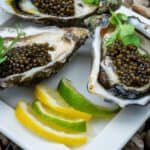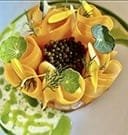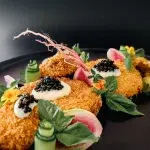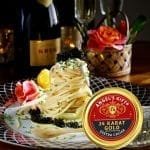No products in the cart.

Introduction to Sturgeon Caviar
Sturgeon caviar, often regarded as one of the pinnacle delicacies in the world of gourmet cuisine, has a storied history that dates back thousands of years. This luxurious food product is derived from the roe of sturgeon fish, a group of ancient species that have existed for over 250 million years. The history of caviar can be traced back to the early civilizations of the Caspian Sea region, where it was celebrated for its rich flavors and exclusive nature, often enjoyed by royalty and dignitaries.
Various types of sturgeon species contribute to the diverse array of caviar available today. Notably, the Beluga, Ossetra, and Sevruga sturgeons each produce distinct caviar varieties characterized by unique flavors and textures. Beluga caviar, known for its large eggs and buttery taste, is often considered the most prestigious, while Ossetra caviar offers a nutty flavor profile and a range of colors. Sevruga, although smaller, is renowned for its powerful flavor, making it a popular choice among culinary enthusiasts.
The production process of sturgeon caviar is meticulous and demanding, significantly contributing to its luxurious status. Harvesting eggs from sturgeons requires expertise, as the fish take years to mature before they can produce caviar. After careful extraction, the roe is salted to enhance its flavor and preserve its freshness. This artisanal approach, combined with the rarity of sturgeon, elevates caviar to a level of culinary luxury enjoyed in fine dining establishments across Europe and the Middle East.
The significance of sturgeon caviar in gourmet cuisine extends beyond mere taste; it symbolizes refinement and elegance. Often featured in upscale settings, such as banquets and celebratory feasts, caviar embodies the richness of culinary traditions. As a result, it remains a sought-after ingredient for chefs and gourmands alike, further solidifying its status as a luxurious delicacy worldwide.
Selecting the Perfect Sturgeon Caviar
Choosing high-quality sturgeon caviar requires careful consideration of several critical factors. The type of sturgeon from which the caviar is sourced significantly impacts the flavor, texture, and overall quality. Popular sturgeon species include Beluga, Osetra, and Sevruga, each offering distinct taste profiles. Beluga caviar is known for its large pearls and buttery flavor, while Osetra offers a nuttier taste. Sevruga, on the other hand, is characterized by its smaller eggs and robust flavor.
The origin of the caviar is another vital aspect. Caviar sourced from specific regions is often regarded as superior due to the environmental conditions and traditional harvesting practices. Renowned caviar-producing areas include the Caspian Sea and the Black Sea, where the unique ecosystems promote the growth of high-quality sturgeon. Furthermore, the grade classifications assigned to caviar can help gauge its quality. Higher grades indicate better flavor, texture, and appearance, often reflecting a lower viscosity and the absence of imperfections in the eggs.
When selecting sturgeon caviar, it is essential to read the labels thoroughly. Look for certifications that denote quality standards, such as sustainably sourced products certified by reputable organizations. This not only ensures a rich culinary experience but also supports responsible caviar production practices. Consumers should also pay attention to whether the caviar is farmed or wild-caught. While both can be of excellent quality, farmed caviar tends to be more sustainable, alleviating pressures on wild stock populations.
Sourcing sturgeon caviar from reputable suppliers is paramount. Established companies often provide transparency regarding their sourcing methods and can assure customers of the product’s quality. By understanding the different options available and focusing on sustainability in caviar production, you can make a more informed and responsible choice.

Gourmet Recipe Inspired by Sturgeon Caviar
Sturgeon caviar, known for its exquisite flavor and luxurious quality, is a delicacy that can elevate a dish to gourmet status. For this refined recipe, we will create a sophisticated blini appetizer topped with sturgeon caviar, crème fraîche, and fresh chives. Below is a detailed list of ingredients and step-by-step preparation instructions.
Ingredients:
- 1 cup buckwheat flour
- 1 cup all-purpose flour
- 1 teaspoon salt
- 1 teaspoon baking powder
- 2 large eggs
- 2 cups buttermilk
- 4 tablespoons melted butter
- 1 cup crème fraîche
- 4 ounces sturgeon caviar
- Fresh chives, chopped, for garnish.
Preparation Instructions:
- In a large bowl, whisk together the buckwheat flour, all-purpose flour, salt, and baking powder.
- In a separate bowl, beat the eggs and mix in the buttermilk and melted butter until well combined.
- Gradually combine the wet and dry ingredients, stirring until the batter is smooth. Allow the mixture to rest for 30 minutes.

- Heat a griddle or skillet over medium heat and lightly grease it. Pour small rounds of batter onto the heated surface, cooking for about 2 minutes on each side or until golden brown.
- Once the blinis are cooked, transfer them to a serving plate.
- To serve, place a dollop of crème fraîche on each blini, followed by a generous spoonful of sturgeon caviar.
- Garnish with freshly chopped chives for an aromatic touch that complements the caviar’s unique flavor profile.
When handling sturgeon caviar, it is essential to use a mother-of-pearl spoon to preserve its delicate taste and texture. To fully enjoy its richness, serve the blinis immediately after assembly, allowing guests to savor the fusion of flavors. Pair this dish with chilled vodka or sparkling wine to enhance the overall dining experience.
Serving and Pairing Suggestions

When it comes to serving sturgeon caviar, presentation is key to enhancing the dining experience. It is essential to use appropriate serving dishes and utensils that not only maintain the caviar’s delicate flavors but also elevate its luxurious appeal. A classic mother-of-pearl or glass caviar spoon is ideal, as metal utensils can alter the taste of this exquisite delicacy. Placing the caviar in a chilled serving bowl, surrounded by crushed ice, helps to maintain its optimal temperature, ensuring that every bite is fresh and flavorful.
For an extravagant presentation, consider serving sturgeon caviar on traditional blinis or lightly toasted baguette slices. These light, neutral bases allow the caviar to shine while providing a delightful contrast in textures. Additionally, accompany the caviar with a selection of condiments such as finely chopped shallots, hard-boiled eggs, or crème fraîche. These garnishes not only enhance the visual appeal but also introduce complementary flavors, creating a more rounded tasting experience.
When pairing beverages with sturgeon caviar, it is important to choose options that will not overpower its nuanced flavors. A classic choice is Champagne—its effervescence and crisp notes beautifully enhance the caviar’s richness. Alternatively, a chilled vodka served neat accentuates the briny flavors while remaining refreshingly smooth. For those who prefer wine, a dry white wine, such as a Sancerre or a Sauvignon Blanc, pairs exceptionally well, balancing acidity with the luxurious saltiness of the caviar.
Finally, consider serving small bites or canapés that harmonize with the caviar. Smoked salmon, oysters, or even fresh herbs can enhance the overall dining experience. With the right serving elements and thoughtful pairings, sturgeon caviar can transform any gathering into a truly memorable occasion, celebrating the luxurious nature of this delicacy.
 Franch
Franch 
















